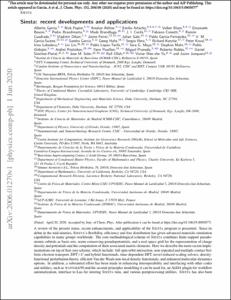Siesta: Recent developments and applications

Visualitza/Obre
Cita com:
hdl:2117/193047
Tipus de documentArticle
Data publicació2020
EditorAIP Publishing
Condicions d'accésAccés obert
Tots els drets reservats. Aquesta obra està protegida pels drets de propietat intel·lectual i
industrial corresponents. Sense perjudici de les exempcions legals existents, queda prohibida la seva
reproducció, distribució, comunicació pública o transformació sense l'autorització del titular dels drets
Abstract
A review of the present status, recent enhancements, and applicability of the Siesta program is presented. Since its debut in the mid-1990s, Siesta's flexibility, efficiency, and free distribution have given advanced materials simulation capabilities to many groups worldwide. The core methodological scheme of Siesta combines finite-support pseudo-atomic orbitals as basis sets, norm-conserving pseudopotentials, and a real-space grid for the representation of charge density and potentials and the computation of their associated matrix elements. Here, we describe the more recent implementations on top of that core scheme, which include full spin-orbit interaction, non-repeated and multiple-contact ballistic electron transport, density functional theory (DFT)+U and hybrid functionals, time-dependent DFT, novel reduced-scaling solvers, density-functional perturbation theory, efficient van der Waals non-local density functionals, and enhanced molecular-dynamics options. In addition, a substantial effort has been made in enhancing interoperability and interfacing with other codes and utilities, such as wannier90 and the second-principles modeling it can be used for, an AiiDA plugin for workflow automatization, interface to Lua for steering Siesta runs, and various post-processing utilities. Siesta has also been engaged in the Electronic Structure Library effort from its inception, which has allowed the sharing of various low-level libraries, as well as data standards and support for them, particularly the PSeudopotential Markup Language definition and library for transferable pseudopotentials, and the interface to the ELectronic Structure Infrastructure library of solvers. Code sharing is made easier by the new open-source licensing model of the program. This review also presents examples of application of the capabilities of the code, as well as a view of on-going and future developments.
CitacióGarcía, A. [et al.]. Siesta: Recent developments and applications. "The Journal of Chemical Physics", 2020, vol. 152, núm. 20.
ISSN1089-7690
Versió de l'editorhttps://aip.scitation.org/doi/10.1063/5.0005077
Col·leccions
| Fitxers | Descripció | Mida | Format | Visualitza |
|---|---|---|---|---|
| SIESTA.pdf | 6,664Mb | Visualitza/Obre |

